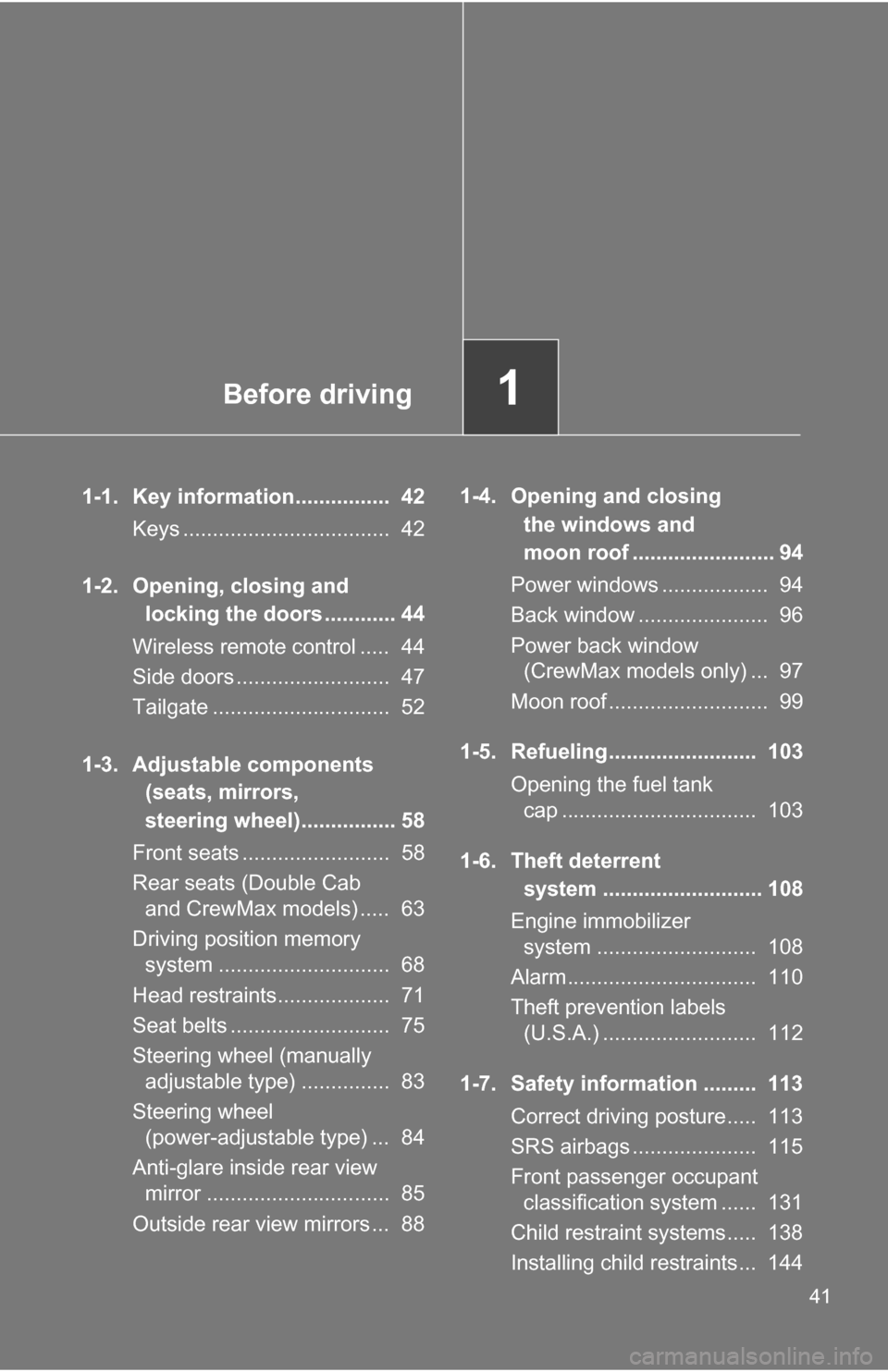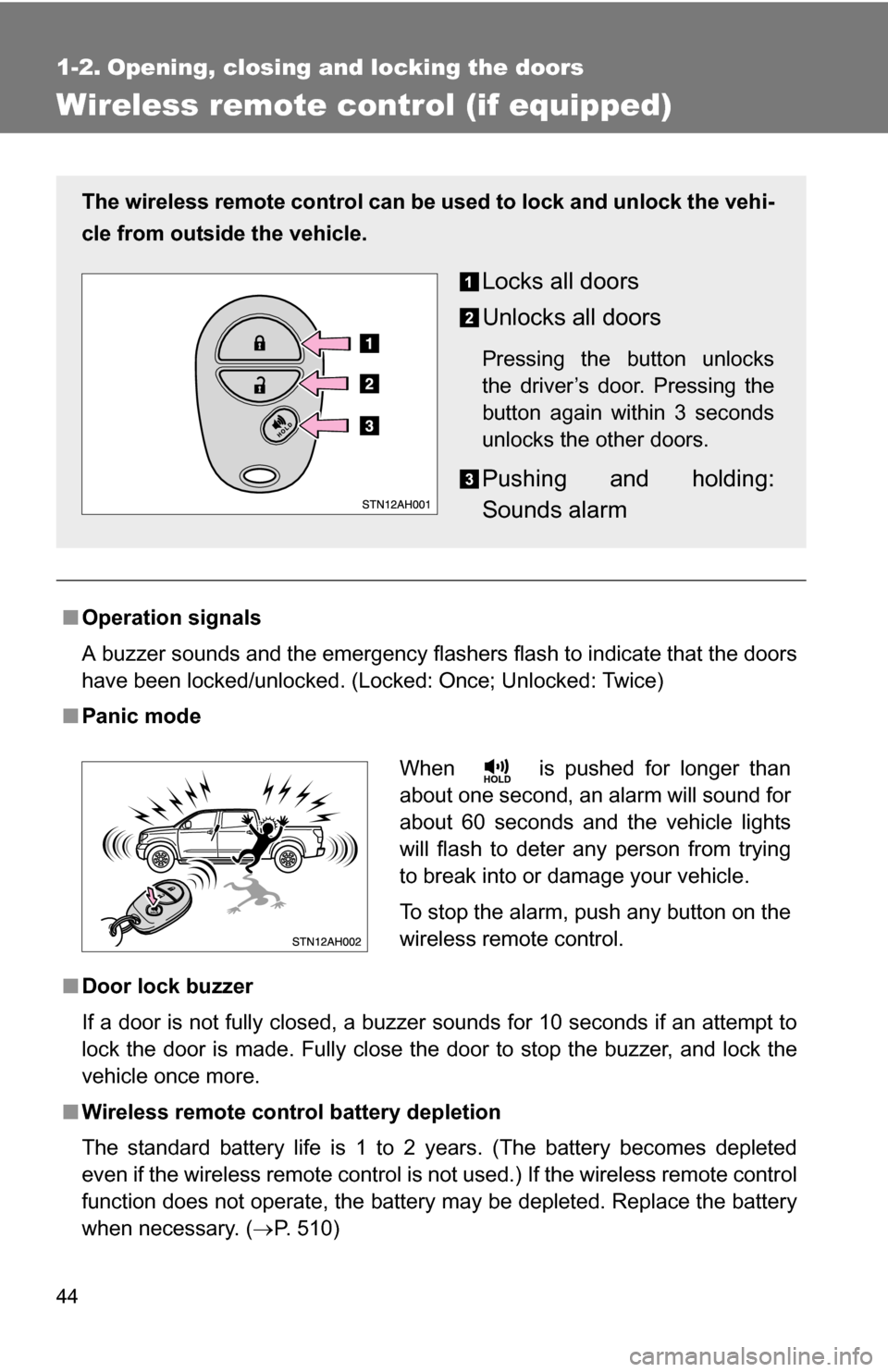Page 35 of 672
35
Instrument panel light
control dial
P. 193
Outside rear view mirror
switches
1 P. 88
Tilt steering lock release lever3/
tilt and telescopic steering lock
release lever
4 P. 83
Personal/interior light
main switch
P. 394
Cargo lamp main switch P. 397
RSCA OFF switch P. 129
Tilt and telescopic steering
control switch
5 P. 84
1: If equipped
2: CrewMax models
3: Front bench type seat
4: Vehicles without driving position memory (front separated type seats)
5: Vehicles with driving position memory
Page 36 of 672

36
For your information
Main Owners Manual
Please note that this manual applies to all models explains and all equip-
ment, including options. Therefore, you may find some explanations for
equipment not installed on your vehicle.
All specifications provided in this manual are current at the time of printing.
However, because of the Toyota policy of continual product improvement, we
reserve the right to make changes at any time without notice.
Depending on specifications, the vehicle shown in the illustrations may differ
from your vehicle in terms of equipment.
Accessories, spare parts and modification of your Toyota
A wide variety of non-genuine spare parts and accessories for Toyota
vehicles are currently available in the market. You should know that Toyota
does not warrant these products and is not responsible for their
performance, repair, or replacement, or for any damage they may cause to,
or adverse effect they may have on, your Toyota vehicle.
This vehicle should not be modified with non-genuine Toyota products.
Modification with non-genuine Toyota products could affect its performance,
safety or durability, and may even violate governmental regulations. In
addition, damage or performance problems resulting from the modification
may not be covered under warranty.
Installation of a mobile two-way radio system
As the installation of a mobile two-way radio system in your vehicle could
affect electronic systems such as the multiport fuel injection system/sequen-
tial multiport fuel injection system, cruise control system, anti-lock brake sys-
tem, SRS airbag system and seat belt pretensioner system, be sure to check
with your Toyota dealer for precautionary measures or special instructions
regarding installation.
Page 41 of 672

Before driving1
41
1-1. Key information................ 42Keys ................................... 42
1-2. Opening, closing and locking the doors ............ 44
Wireless remote control ..... 44
Side doors .......................... 47
Tailgate .............................. 52
1-3. Adjustable components (seats, mirrors,
steering wheel)................ 58
Front seats ......................... 58
Rear seats (Double Cab and CrewMax models) ..... 63
Driving position memory system ............................. 68
Head restraints................... 71
Seat belts ........................... 75
Steering wheel (manually adjustable type) ............... 83
Steering wheel (power-adjustable type) ... 84
Anti-glare inside rear view mirror ............................... 85
Outside rear view mirrors ... 88 1-4. Opening and closing
the windows and
moon roof ........................ 94
Power windows .................. 94
Back window ...................... 96
Power back window (CrewMax models only) ... 97
Moon roof ........................... 99
1-5. Refueling......................... 103 Opening the fuel tank cap ................................. 103
1-6. Theft deterrent system ........................... 108
Engine immobilizer system ........................... 108
Alarm................................ 110
Theft prevention labels (U.S.A.) .......................... 112
1-7. Safety information ......... 113 Correct driving posture..... 113
SRS airbags ..................... 115
Front passenger occupant classification system ...... 131
Child restraint systems..... 138
Installing child restraints... 144
Page 42 of 672
42
1-1. Key information
Keys
■When required to leave a key to the vehicle with a parking attendant
Lock the glove box as circumstances demand. ( P. 400)
Carry the master key for your own use and leave the valet key only with the
attendant.
■ Key number plate
Keep the plate in a safe place such as your wallet, not in the vehicle. In the
event that a key is lost, a new key can be made by your Toyota dealer using
the key number plate. ( P. 580)
The following keys are provid ed with the vehicle.
Vehicles without engine immobilizer system
Master keys
Va l e t k e y
Key number plate
Vehicles with engine immobilizer system Master keys
Va l e t k e y
Key number plate
Page 43 of 672
43
1-1. Key information
1
Before driving
NOTICE
■
To prevent key damage (vehicles with engine immobilizer system)
● Do not subject the keys to strong shocks, expose them to high tempera-
tures by placing them in direct sunlight, or get them wet.
● Do not expose the keys to electromagnetic materials or attach any mate-
rial that blocks electromagnetic waves to the key surface.
Page 44 of 672

44
1-2. Opening, closing and locking the doors
Wireless remote control (if equipped)
■Operation signals
A buzzer sounds and the emergency flashers flash to indicate that the doors
have been locked/unlocked. (Locked: Once; Unlocked: Twice)
■ Panic mode
■ Door lock buzzer
If a door is not fully closed, a buzzer sounds for 10 seconds if an attempt to
lock the door is made. Fully close the door to stop the buzzer, and lock the
vehicle once more.
■ Wireless remote control battery depletion
The standard battery life is 1 to 2 years. (The battery becomes depleted
even if the wireless remote control is not used.) If the wireless remot\
e control
function does not operate, the battery may be depleted. Replace the battery
when necessary. ( P. 510)
The wireless remote control can be used to lock and unlock the vehi-
cle from outside the vehicle.
Locks all doors
Unlocks all doors
Pressing the button unlocks
the driver’s door. Pressing the
button again within 3 seconds
unlocks the other doors.
Pushing and holding:
Sounds alarm
When is pushed for longer than
about one second, an alarm will sound for
about 60 seconds and the vehicle lights
will flash to deter any person from trying
to break into or damage your vehicle.
To stop the alarm, push any button on the
wireless remote control.
Page 45 of 672

45
1-2. Opening, closing and locking the doors
1
Before driving
■
If the wireless remote control does not operate
Locking and unlocking the doors: Use the key. ( P. 47)
■ Security feature
If a door is not opened within approximately 60 seconds after the vehicle is
unlocked, the security feature automatically locks the vehicle again.
■ Alarm (if equipped)
Using the wireless remote control to lock the door will set the alarm sy\
stem.
(P. 110)
■ Conditions affecting operation
The wireless remote control function may not operate normally in the follow-
ing situations.
●Near a TV tower, radio station, electr ic power plant, airport or other facil-
ity that generates strong radio waves
● When carrying a portable radio, cell ular phone or other wireless commu-
nication device
● When multiple wireless keys are in the vicinity
● When the wireless key has come into contact with, or is covered by a
metallic object
● When a wireless key (that emits radio waves) is being used nearby
● When the wireless key has been left near an electrical appliance such as
a personal computer
■ Customization
●That can be configured at Toyota dealer (vehicles without multi-informa-
tion display)
Settings (e.g. wireless remote control) can be changed.
(Customizable features P. 633)
● It is possible to change the settings (vehicles with multi-information dis-
play) (Feature customization P. 200)
Page 46 of 672
46 1-2. Opening, closing and locking the doors
■Certification for wireless remote control
For vehicles sold in U.S.A.
NOTE:
This device complies with Part 15 of the FCC Rules. Operation is subject to
the following two conditions: (1) this device may not cause harmful interfer-
ence, and (2) this device must accept any interference received, including
interference that may cause undesired operation.
For vehicles sold in Canada
NOTE:
Operation is subject to the following two conditions: (1) This device may not
cause interference, and (2) this device must accept any interference, includ-
ing interference that may cause undesired operation of the device.